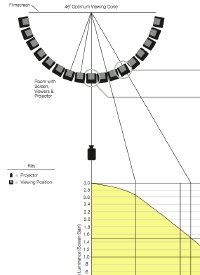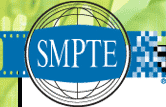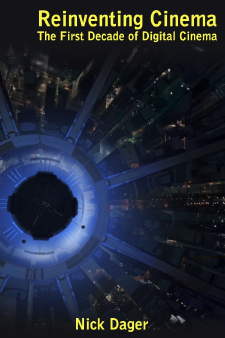The MPEG working group ise looking for a new compression standard which would be “in line with the expected usage models of the internet”. It would like the new standard to achieve “substantially better compression performance” than MPEG-2 and is hoping it may be comparable with the H.264/MPEG-4 AVC baseline profile.
This article derives from H-Online’s article:
MPEG calling for royalty-free web video codec
The issue of video codecs has been particularly controversial over the last year with the emergence of Google’s royalty free WebM/VP8 codec taking on the MPEG groups’s royalty encumbered H.264 codec. Last week, MPEG LA, a patent pooling company not connected to the ISO/IEC MPEG group, announced that it was beginning a search for patents essential to VP8 with an eye to creating a patent pool and charging royalties. Royalties for the use of H.264 for video on the internet were dropped in August 2010, but are still required to be paid by the makers of web browsers and video encoders.
Currently, it is unknown how many of, or how enthusiastically, the participants in MPEG will rise to the call for proposals. The March meeting of the MPEG group will be held in Geneva, Switzerland, over the 21st to the 25th.
Following is the press release from MPEG
MPEG anticipates March 2011 CfP for Type-1 Video Coding Standard
MPEG has been producing standards that provide industry with the best video compression technologies. In recognition of the growing importance that the Internet plays in the generation and consumption of video content, MPEG intends to develop a new video compression standard in line with the expected usage models of the Internet. The new standard is intended to achieve substantially better compression performance than that offered by MPEG-2 and possibly comparable to that offered by the AVC Baseline Profile. MPEG will issue a call for proposals on video compression technology at the end of its upcoming meeting in March 2011 that is expected to lead to a standard falling under ISO/IEC “Type-1 licensing”, i.e. intended to be “royalty free”.
MPEG moves toward a visual search standard by issuing Draft Call for Proposals
In its latest step toward creating a standard for efficient and interoperable designs of visual search applications, MPEG has issued a draft Call for Proposals at its 95th meeting. Like a barcode reader, but using regular images instead of barcodes, visual search enables the retrieval of related information from databases for tourists, simplified shopping, mobile augmented reality, and other applications.
Specifically, the call seeks technologies that deliver robust matching of images of objects, such as landmarks and text-based documents, that may be partially occluded or captured from various vantage points, and with different camera parameters, or lighting conditions. The underlying component technologies that are expected to be addressed by the standard include the format of the visual descriptors, and parts of the descriptor extraction process needed to ensure interoperability. Other component technologies, such as indexing and matching algorithms, may also be incorporated into the new standard.
Further details are outlined in the text of the call available at http://mpeg.chiariglione.org/hot_news.htm. The Final Call for Proposals will be issued at the 96th MPEG meeting in March 2011 with responses due in October 2011.
MPEG targets a new phase of 3D video coding standards
A Draft Call for Proposals on 3D Video Coding Technology has also been issued by MPEG at its 95th meeting. This call invites technology submissions providing efficient compression of 3D video and high quality view reconstruction that goes beyond the capabilities of existing standards. MPEG has already delivered 3D compression formats to the market, including MVC and frame-compatible stereoscopic formats, which are being deployed by industry for packaged media and broadcast services. However, the market needs are expected to evolve and new types of 3D displays and services will be offered. With this call, MPEG embarks on a new phase of 3D standardization that anticipates these future needs. The next-generation of 3D standards will define the 3D data format and associated compression technology to facilitate the generation of multiview output to enable both advanced stereoscopic display processing and improved support for auto-stereoscopic displays. Further details are outlined in MPEG’s Vision on 3D Video (http://mpeg.chiariglione.org/visions/3dv/index.htm). The Final Call for Proposals will be issued at the 96th MPEG meeting in March 2011 with responses due in September 2011.
Amendment to MPEG-2 systems is finalized at 95th meeting
MPEG is continuously improving the popular MPEG-2 Transport Stream (TS) standard (ISO/IEC 13818-1), one of its most widely accepted standards for broadcast industries. At its 95th meeting, MPEG has finalized a new amendment to support recently developed video coding standards, Advanced Video Coding (AVC) and Multiview Video Coding (MVC), in MPEG-2 TS. This amendment extends the AVC video descriptor to signal the presence of a frame packing arrangement in an associated supplemental enhancement information message for the underlying AVC video stream component. The new amendment also adds signaling of an operating point descriptor of MVC which enables transmission systems to convey the relevant operating points that can be used by receiving devices.
In a related project, MPEG has also started a new amendment to signal stereoscopic video services carried in MPEG-2 TS. This amendment will support not only frame compatible video services but also service compatible video services which will allow implementation of backward compatible stereoscopic video services in HDTV systems.
MPEG hosts MPEG-V awareness event
At its 95th meeting, MPEG hosted the MPEG-V Awareness Event 2011, at which the full range of MPEG-V technologies, including several products and applications employing the standard, were showcased. These technologies cover applications for multi-sensorial user experience in the home environment, control of virtual worlds by real signals, motion capture systems and real-time avatar animation, multi-platform streaming for virtual worlds and mixed reality games. The workshop presentations are available at http://wg11.sc29.org/mpeg-v.
A hot standard moves fast
MPEG has approved the promotion of Dynamic Adaptive Streaming over HTTP (DASH) to Draft International Standard (DIS) status. The draft is available from the Hot News page of http://mpeg.chiariglione.org.
Responding to a Call – How to Contact MPEG
The text and details related to the Calls mentioned above (together with other current Calls) are in the Hot News section,http://www.chiariglione.org/mpeg/hot_news.htm. These documents include information on how to respond to the Calls.
Communicating the large and sometimes complex array of technologies that the MPEG Committee has developed is not a simple task. Experts, past and present, have contributed a series of tutorials and vision documents that explain each of these standards individually. The repository is growing with each meeting, but if something of interest cannot be found, do not hesitate to request it. You can start your MPEG adventure at:http://mpeg.chiariglione.org/technologies.htm.
Further Information
Future MPEG meetings are planned as follows:
| No. 96 |
Geneva |
CH |
21-25 |
March |
2011 |
| No. 97 |
Torino |
IT |
18-22 |
July |
2011 |
| No. 98 |
Geneva |
CH |
28-02 |
November-December |
2011 |
| No. 99 |
San Jose |
US |
06-10 |
February |
2012 |
For further information about MPEG, please contact:
| Dr. Leonardo Chiariglione (Convener of MPEG, Italy) |
| Via Borgionera, 103 |
| 10040 Villar Dora (TO), Italy |
| Tel: +39 011 935 04 61 |
| [email protected] |
This press release and other MPEG-related information can be found on the MPEG homepage:
http://mpeg.chiariglione.org/
The MPEG homepage also has links to other MPEG pages which are maintained by the MPEG subgroups. It also contains links to public documents that are freely available for download by those who are not MPEG members. Journalists that wish to receive MPEG Press Releases by email should contact Dr. Arianne T. Hinds at [email protected].




